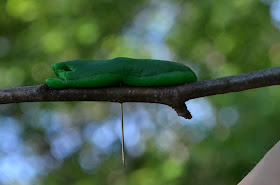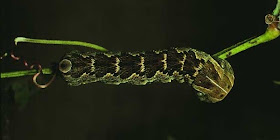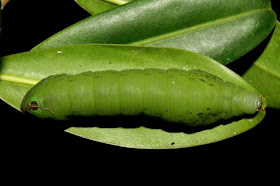 |
| Pastry "caterpillar" used to examine the protective effect of eyespots and defensive posture of caterpillars. |
The vast majority of the caterpillars with eyespots that I have had a chance to examine have some form of defensive posturing upon perceiving a threat. Some species tuck their head under their body and puff up their thoracic body segments (e.g., Papilio canadensis, Papilio troilus), while others pull their head telescopically into their body which also puffs up their thoracic segments (e.g., Xylophanes sp.). The suggestion has been that this defensive posture augments the protective effect of eyespots.
 |
| Papilio canadensis caterpillar on a branch in its defensive posture. This is my photo of a caterpillar that I reared for another project. |
 |
| Xylophantes juanita (Sphingidae) caterpillar in defensive posture. Photo from Janzen & Hallwachs database. |
There are a few reasons why the defensive posture might increase the protective effect of eyespots. First, it could help emphasize the markings to an attacker by drawing attention or emboldening the spots. Second, it may help the caterpillar appearing larger enabling it to buff predators away from attack. Finally, this posture might make the anterior body segments resemble the head, perhaps increasing overall resemblance to a snake by placing the false eyes (i.e., eyespots) in the context of a "head". Interestingly, several caterpillars engage in a similar defensive posture, including some with poorly developed eyespots or where eyespots are lacking altogether. Thus "head-shape" might be a mimetic signal in and of itself. Our goal was to test whether eyespots and the defensive posture protect caterpillars from birds, and if so, does having both traits increase protection even more?
Materials & Methods
It wasn't possible to deploy real caterpillars in the field, so we used artificial caterpillars made of flour and lard. We had observed previously that eyespots were more effective when the caterpillars were two-toned (i.e., countershaded), so we made all our prey two-toned by combining dark and light green dough (dyed with food colouring). All caterpillars were formed into 4 cm long cylinders, then to make the "defensive posture" prey we pressed these half of these caterpillars into a mould made from plaster of Paris. This ensured that all model prey (rest or defensive posture) the same volume, just like a real caterpillar that has shifted its posture.
 |
| Preparing to make the mould for this experiment |
 |
| The finished mould. It cracked in half when I was removing it. |
Over the course of a summer we made and deployed 576 model caterpillars, divided evenly among four treatments:
- No eyespots - Resting posture
- Eyespots - Resting posture
- No eyespots - Defensive posture
- Eyespots - Defensive posture
 |
| No eyespot - Resting posture treatment |
 |
| No eyespot - Defensive posture treatment |
 |
| Eyespot - Defensive posture (above) and Eyespots - Resting posture (below) treatments. |
Model prey were deployed in the field by pinning them to tree branches. Each tree had four caterpillars - one of each treatment. We deployed caterpillars 6 times (i.e., 96 prey deployed each time), always in a new location, then tracked their survival three times a day over the next 90 h. Sometimes prey were gone, other times they were riddled with peck marks. Here are some examples of pecked "caterpillars" from the field:
Results & Interpretation
Our results showed that both the defensive posture and eyespots reduced the number of attacks, but having both traits didn't further increase the protection. This was surprisingly consistent with another recent study that examined rates of predation on model snakes with a viper-like head shape and/or zigzag patterning (Valkonen et al. 2011). They too found that possessing either trait conferred protection, but having both traits didn't increase that protection further. This seems to make sense - if either trait indicates risk from a threat, having both traits may help better identify that threat but doesn't change the risk associated with it. It is still unclear though how predators decide which cues reliably indicate a threat and which do not. A better understanding of this learning process might also help us understand why so many mimics only vaguely resemble their model.
 |
| Figure 2 from Valkonen et al 2011 showing number of raptor attacks on snake replicas |
See the full Valkonen et al 2011 paper for free here:
Valkonen JK, Nokelainen O, Mappes J (2011) Antipredatory Function of Head Shape for Vipers and Their Mimics. PLoS ONE 6(7): e22272. doi:10.1371/journal.pone.0022272
We also looked at the number of pecks per caterpillar as well as where they were pecked. Caterpillars with both eyespots and the enlarged "head" shape received more "head"-directed pecks that caterpillars with either trait alone. Assuming birds direct their attacks toward a prey or predator's head, this might mean that birds still do perceive the anterior segments as more head-like when they have both traits - just not enough to deter their attack/curiosity.
The next step for this research is to see if we can determine why the wide "head" defensive posture works. Of course the leading hypothesis is that this posture makes the caterpillar look more snake-like, or perhaps more like a viper. To make this argument convincingly you would need to show that these caterpillars look more like snakes (or perhaps vipers specifically) when they are in their defensive posture compared to when they are at rest. We are currently working on a project that examines whether or not this is the case using photos of preserved snakes and live caterpillars.
References:
Hossie, T. J., Sherratt, T. N. (2013) Defensive posture and eyespots deter avian predators from attacking caterpillar models. Animal Behaviour [Early View]





















